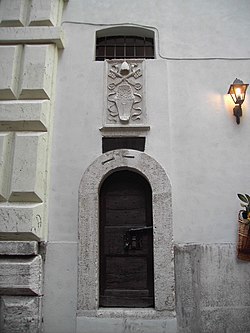Santa Maria Odigitria al Tritone

Santa Maria Odigitria, sometimes Santa Maria dei Siciliani, is a Roman Catholic church in Rome, located at civico 82 on via del Tritone in the Colonna district. The Confraternity of the Sicilians was officially recognized by the papal bull "Pastoris aeterni" of Pope Clement VIII on 5 February 1594 and immediately began construction. The building, consecrated on 17 August 1596, was from the first the national church of Sicily, then ruled by the Crown of Aragon. Upon the integration of Sicily into Italy, it became regional rather than a national church. It is named after the icon of the Virgin Mary venerated in the church – it is of the Hodegetria ("She Who Shows the Way") type and was brought to Rome from Constantinople. The confraternity also had an oratory adjoining the church, which now displays a painting of Saint Rosalia by the Sicilian painter Gaetano Sottino. During the French occupation of Rome from the end of the 18th century to the start of the 19th century, the church was deconsecrated. It was rebuilt by Francesco Manno between 1814 and 1817. In 1990 its four side chapels were used to display four altar frontals by Giuseppe Migneco (showing popes Leo II, Agaton and Methodius), Salvatore Fiume (Saint Lucy), Sebastiano Milluzzo (Saint Agatha), and Mario Bardi (Saint Rosalia). Pope Paul VI made the church a cardinal deaconry on 12 February 1973 by the apostolic constitution "Romana templa".
Excerpt from the Wikipedia article Santa Maria Odigitria al Tritone (License: CC BY-SA 3.0, Authors, Images).Santa Maria Odigitria al Tritone
Via del Tritone, Rome Municipio Roma I
Geographical coordinates (GPS) Address External links Nearby Places Show on map
Geographical coordinates (GPS)
| Latitude | Longitude |
|---|---|
| N 41.9032 ° | E 12.485930555556 ° |
Address
Santa Maria d'Itria
Via del Tritone
00187 Rome, Municipio Roma I
Lazio, Italy
Open on Google Maps











